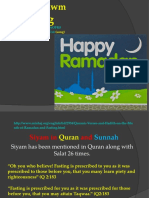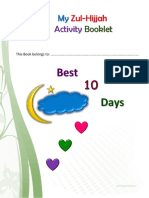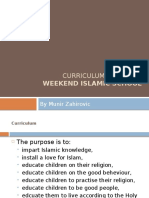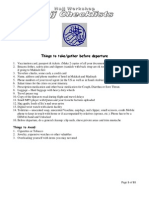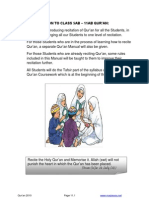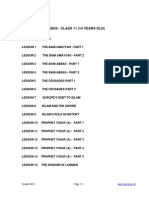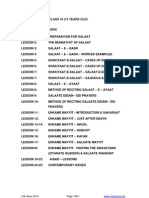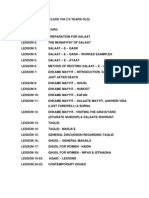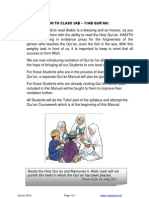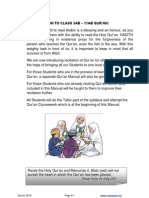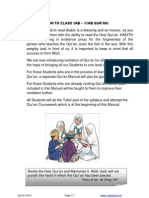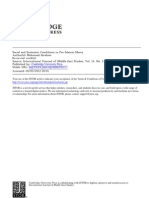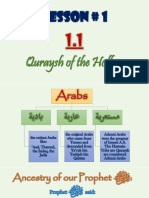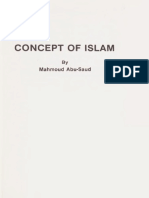Introduction To Class 1 - 4 Qur'An
Introduction To Class 1 - 4 Qur'An
Uploaded by
almustafaphilsCopyright:
Available Formats
Introduction To Class 1 - 4 Qur'An
Introduction To Class 1 - 4 Qur'An
Uploaded by
almustafaphilsOriginal Title
Copyright
Available Formats
Share this document
Did you find this document useful?
Is this content inappropriate?
Copyright:
Available Formats
Introduction To Class 1 - 4 Qur'An
Introduction To Class 1 - 4 Qur'An
Uploaded by
almustafaphilsCopyright:
Available Formats
INTRODUCTION TO CLASS 1 – 4 QUR’AN:
Teaching a child to read Arabic is a blessing and an honour, as you are equipping
them with the ability to read the Holy Qur’an. HADITH about everything in existence
prays for the forgiveness of the person who teaches the Qur’an, even the fish in the
sea. With this weighty task in front of us, it is important to keep in mind that all
success is from Allah.
We are now introducing recitation of Qur’an for the younger children, in the hope of
bringing all our children to one level of recitation.
For those children who are in the process of learning how to recite Qur’an, a
separate Qur’an Manual will also be given.
For those children who are already reciting Qur’an, some rules included in this
Manual will be taught to them to improve their recitation further.
All children will do the Tafsir and Az Zahra part of the syllabus.
Recite the Holy Qur’an and Memorise it. Allah will not punish the
heart in which the Qur’an has been placed.
(Imam Ja’far As Sadiq (A))
Qur’an 2010 Page 4.1 www.madressa.net
QUR’AN SYLLABUS CLASS 4 (7 YEARS OLD)
LESSON: TOPIC
LESSON 1: INTRODUCTION AND TERMINOLOGY
LESSON 2: RESPECT OF RECITING THE QUR’AN
LESSON 3: TAFSIR OF SURATUN QADR
LESSON 4: TAFSIR OF SURATUL ASR
LESSON 5: TAFSIR OF SURATUL FIL
LESSON 6: MEMORISATION FOR AZ-ZAHRA – SURATUL ZILZAL
LESSON 7: MEMORISATION FOR AZ ZAHRA - SURATUL KAUTHAR
LESSON 8: MEMORISATION FOR AZ-ZAHRA – SURATUL LAHAB
LEVEL 5: FURTHER RULES FOR CHILDREN WHO CAN RECITE QUR’AN:
- PUNCTUATION
- QALQALA
- RULES OF LAAM
- RULES OF NOON AND MEEM MUSHADDADAH
- WAJIB SAJDAHS IN THE QUR’AN
- ARABIC NUMBERS
Qur’an 2010 Page 4.2 www.madressa.net
LESSON 1: INTRODUCTION AND TERMINOLOGY:
Qur’an as a Gift:
(Introduce the Qur’an as a gift from Allah. Show the children a Qur’an wrapped up as
a gift. Ask the children what they think is inside it. Tell them it is something precious
and a gift they can keep for life. Open it and show them what the whole Qur’an looks
like, what the Arabic is like, how it is read etc.)
Ramadhan has just gone; this was the month the Qur’an was revealed. What
presents did you get on Eid? Allah’s present to you is the Qur’an.
What is the Holy Qur'an?
¾ t
It is a book that contains the words of Allah. Ç
Who wrote the Holy Qur'an?
It was not written by anyone; Allah sent down the words to the Holy Prophet (S)
through the Angel Jibrail – over a period of about 23 years
The Holy Prophet (S) then recited the verses to the people. Most of the people would
remember the verses by heart but the Holy Prophet (S) chose some special people
called scribes to write down the verses.
In which language is the Holy Qur'an written?
It is written in Arabic.
T P L A
Arabic is read from right to left and back to front.
What does Allah tell us in the Holy Qur'an? We have to look after the
- He tells us true stories of the Prophets.
Holy Qur'an because it is
- He tells us how He wants us to act.
such a special book.
- He tells us about heaven and hell.
-
TERMINOLOGY:
Aya = Ayaat (pl.) = One verse of the Qur'an.
Sura = Suwer (pl.) = One chapter of the 114 chapters of the Qur'an
Waqf = Wuqoof (pl.) = Punctuation marks.
Juz = Ajzaa (pl.) = The Qur'an is divided into 30 equal parts.
Each of these parts is called a Juz.
Rub’a = Marking indicating ¼ of a Juz.
Nisf = Marking indicating ½ of a Juz.
Thuluth = Marking indicating ¾ of a Juz
Qur’an 2010 Page 4.3 www.madressa.net
LESSON 2: RESPECT OF RECTING THE HOLY QUR'AN
Never touching the writing in it without first doing Wudhu
The intention when reciting Qur’an should be to for the Pleasure of Allah
We should not recite too loudly so as to disturb others
We must hold the Qur’an properly (Show the child)
Never leaving it open when no-one is reciting it.
We must try and face Qiblah while reciting the Qur’an
You can read it without touching it, or put a plastic sheet on it
When reciting the Holy Qur’an, we must try and take care of the following:
for boys to for girls to to face Qiblah
wear a cap wear a scarf. (the Ka’aba)
Before starting to recite the Holy Qur’an, you should say:
I seek refuge in Allah from Shaitan the outcast
AND
I begin in the name of Allah, the Most Kind, the Merciful
Qur’an 2010 Page 4.4 www.madressa.net
LESSON 3: TAFSIR OF SURATUL QADR:
Á@æÎêYìj»A øÅ{ÀæYìj»A êÉé}¼»A øÁænøI
Ó¼u X
øiæfä´ô»A êÒò¼æÎò» æÓê¯ åÉ{Äô»älæÃòA FìÃA
¢
øiæfä´ô»A åÒò¼æÎò» Bä¿ òº{iæeòA Fä¿ äË
¢
ùjæÈäq ê±ô»òA æÅéê¿ èjæÎäaÜøiæfä´ô»A åÒò¼æÎò»
Ü
ùjæ¿òA ÷½ó· æÅê¿XæÁøÈéøIäi øÆægêBøI BäÈæÎê¯ å`æËíj»AäË åÒò¸ê×}¼äÀô»A ó¾ìläÄäM
X
øjæVä°ô»A ø©ò¼ôñä¿ Óé{NäY äÓêDZ³ èÁ}¼äm
This Surah was revealed in Makka.
It has 5 verses.
The word "al-Qadr" = "Glorious" or "Highest Ranking".
Qur’an 2010 Page 4.5 www.madressa.net
LESSON 3: TAFSIR OF SURATUL QADR:
In the night of Qadr, whatever everyone is to receive in the next year is decided.
This is why the Holy Prophet (S) has told us to stay awake the whole night in prayer,
asking for forgiveness and asking for our wishes.
Ayat 1: The Holy Qur'an was revealed in its full chapter by chapter form to the
Holy Prophet (S) on this night. He then related it to the people in
sections as and when instructed by Allah through Angel Jibrail.
Ayat 2: This challenge is a clue that human beings cannot fully understand the
blessings of this night.
Ayat 3: The "thousand months" means a very long time. It means that a
moment of understanding gained in this night under Allah's special
guidance is better than a thousand months spent in ignorance.
Ayat 4: This describes the constant traffic of angels and Jibrail coming down to
the earth throughout the night, offering Allah's Blessings to the
believers who are awake, worshipping Him.
Ayat 5: This verse indicates that the peace due to the special Mercy of Allah on
this night continues all the way till the next day.
The Holy Prophet (S has said that Allah regards one who recites this Surah as
though s/he fasted the month of Ramadhan and spent Laylatul Qadr worshipping
his/her Creator.
Qur’an 2010 Page 4.6 www.madressa.net
WORKSHEET 3: TAFSIR OF SURATUL QADR:
Draw below what you have learnt from Suratul Qadr
Suratul Qadr
Qur’an 2010 Page 4.7 www.madressa.net
LESSON 4: TAFSIR OF SURATUL ASR:
ø Á@æÎêYìj»A øÅ{ÀæYìj»A êÉé}¼»A øÁænøI
Ü
øjævä¨ô»A äË
Ü
ùjænåa æÓê°ò» äÆBänæÃæêÜA ìÆêA
O{Zê¼é{v»A AæÌó¼êÀä§ äË AæÌåÄä¿}A äÅæÍêhú»A úÜêA
ê
ª
øjæJìv»BøI AæÌuAäÌäM äË Ü éμäZô»BøI AæÌäuAäÌäM äË
This Surah was revealed in Makka.
It has 3 verses.
The name of the Surah comes from the subject of its 1st Verse.
The Surah deals with the teaching of truth and patience.
Qur’an 2010 Page 4.8 www.madressa.net
LESSON 4: TAFSIR OF SURATUL ASR:
Ayat 1: "Asr" = "time" and refers to the continuous change as time moves on.
Some scholars say it refers to the time when Imam Mahdi (a.s.) will re-
appear. Here Allah is swearing by that time.
Ayat 2: By saying man is in a loss, it means that people are so easily led astray
by everything of this world, and unless they are careful, they will get
lost in running after these worldly things and forget Allah.
The next verse gives the qualities of those who have remained on the path of Allah.
The Holy Prophet (S) was asked about “loss” and he said, “Those who do
not believe in my Ahlul Bayt are at a loss”
Ayat 3: We can see from this verse that the best of actions are to:
o have faith in Allah. This means believing and acting upon whatever He
has commanded.
o do good deeds, to please Allah.
o encourage people to the right path. Try to spread the message of Islam
by your words and actions.
o be patient. Even when we do not get what we want, we should trust in
Allah and be patient. He knows what is good for us.
The Holy Prophet (s.a.w.) has said that whoever recites
this Surah will be in the right group on the Day of Judgement.
Qur’an 2010 Page 4.9 www.madressa.net
WORKSHEET 4: TAFSIR OF SURATUL ASR:
Draw below what you have learnt from Suratul Asr
Suratul Asr
Qur’an 2010 Page 4.10 www.madressa.net
LESSON 5: TAFSIR OF SURATUL FIL:
øÁ@æÎêYìj»A øÅ{ÀæYìj»A êÉé}¼»A øÁænøI
¢
ø½æÎê°ô»A øLBäZæuòBøI ò¹íIäi ò½ä¨ò¯ ä±æÎò· äjäM æÁò»òA
Ü
ù½æÎê¼æzäM æÓê¯ æÁåÇäfæÎò· ô½ä¨æVäÍ æÁò»òA
Ü
ò½æÎøIBäøIòA AçjæÎò¢ æÁøÈæÎò¼ä§ ò½ämæiòA ìË
Üx
ù½æÎéøVêm æÅéê¿ ëÑäiBäVêZøI æÁøÈæÎê¿æjäM
ª
ù¾æÌó·ôBì¿ ë±ævä¨ò· æÁåÈò¼ä¨äVò¯
This Surah was revealed in Makka.
It has 5 verses.
"Al-Fil" means "The Elephant". The name of the Surah comes from the army of
elephants mentioned in the first verse.
Qur’an 2010 Page 4.11 www.madressa.net
LESSON 5: TAFSIR OF SURATUL FIL:
In 570 AD, the year of the birth of our
Holy Prophet (s.a.w.), a Christian governor
called Abraha marched to Makka to destroy
the Holy Kaa'ba.
He wanted to destroy the Kaa'ba, because
he wanted people to come and worship at
a huge church he had built in Yemen.
Abraha's army also had elephants, which wasn’t very
common in Arabia. History calls this army "Ashabul Fíl"
or "The People of the Elephant".
When he reached Makka, he captured some camels
belonging to the chief of Makka, Abdul Muttalib, the grandfather of the Holy Prophet
(S). When Abdul Muttalib went to see him, Abraha thought he would ask him to
spare the Holy Kaa'ba. Instead, Abdul Muttalib asked for the camels to be returned.
Abraha laughed and said, "What! I have come to destroy your place of worship, and
you are speaking of your camels!" Abdul Muttalib gave a famous reply, "I am the
owner of the camels, so I have come for them. The Kaa'ba too has an Owner,
Who will look after it". This statement showed that the ancestors of the Holy
Prophet (s.a.w.) were also firm in their faith in Allah.
Abraha ignored this warning and tried to invade the Holy Kaa`ba with his elephants.
The Surah tells what happened to the army:
Ayat 1: Small birds carrying little stones
in their beaks and claws crushed
the proud army. Each stone fell on
target, killing men and animals
instantly. Allah shows how the power
displayed by Abraha was defeated by
the smallest of His creatures.
Ayat 2: This verse refers to the great confusion caused in the army of Abraha
by the arrival of the birds. Many fell dead, and the survivors, including
Abraha, began to run away.
Ayat 3 &4: The birds were tiny, yet their effect was great, because they had the
help of Allah.
Ayat 5: The appearance of the remains of the army after the birds had left was
like straw that has been chewed by cows, broken and useless.
Imam Ja'far as-Sadiq (A) has written in his own handwriting:
"When you face your enemy, look at him and recite Suratul Fil".
Qur’an 2010 Page 4.12 www.madressa.net
WORKSHEET 5: TAFSIR OF SURATUL FIL:
Draw below what you have learnt from Suratul Fil:
Suratul Fil
Qur’an 2010 Page 4.13 www.madressa.net
LESSON 6: MEMORISATION FOR AZ-ZAHRA - SURATUL ZILZAL:
ãÈ×ãcáäoÂB ãÌÇåcáäoÂB ãÐÃÂB ãÈåtãQ
ý1þ CáÏáÂBáqåÂãp â¡ånáÛåB ãYáÂãqåÂâp BálãH
ý2þ CáÏáÂCá»å[áF â¡ånáÛåB ãYá_áoågáFáÑ
ý3þ CáÏá CáÆ âÉCátÊãåßB áÁCáºáÑ
ý4þ CáÎánCáRågáF âZãäkádâW èmãNáÆåÒáÖ
ý5þ CáÏá ÔácåÑáF áÀáäQán áäÉáGãQ
ý6þ åÈâÏáÂCáÇå®áF BåÑáoâ×ãä CæWCáXåwáF ârCáäËÂB ânâkå|áÖ èmãNáÆåÒáÖ
ý7þ âÍáoáÖ Bæoå×ág èTáänál áÁCá»å\ãÆ åÄáÇåˉáÖ ÌáÇá¶
ý8þ âÍáoáÖ Bæäoáw èTáänál áÁCá»å\ãÆ åÄáÇåˉáÖ ÌáÆáÑ
Qur’an 2010 Page 4.14 www.madressa.net
LESSON 6: MEMORISATION FOR AZ-ZAHRA – SURATUL ZILZAL:
For the Az-Zahra Certificate, your child should know:
- Suratul Zilzal with proper Makhraj.
__________________ has been tested on the above requirements and has
performed satisfactorily.
________________________ _________________
Signature of teacher: Date
If the child has not passed the test satisfactorily the teacher should fill in the
letter below.
Dear Parent,
Your child __________________ was tested on Suratul Zilzal but s/he did not know
it.
Please ensure that s/he knows the above for next week, so that s/he may receive
their Az-Zahra Certificate.
__________________________ __________________
Signature of teacher Date
Qur’an 2010 Page 4.15 www.madressa.net
LESSON 7: MEMORISATION FOR AZ-ZAHRA - SURATUL KAUTHAR:
øÁ@æÎêYìj»A øÅ{ÀæYìj»A êÉé}¼»A øÁænøI
¢
äjäQæÌò¸ô»A ò¹{ÄæÎòñæ§òA F@ìÃêA
¢
æjäZæÃAäË ò¹éøIäjê» ÷ø½ävò¯
ª
åjäNæIæòÜA äÌåÇ ò¹ä×êÃBäq ìÆêA
Qur’an 2010 Page 4.16 www.madressa.net
LESSON 7: MEMORISATION FOR AZ-ZAHRA – SURATUL KAUTHAR:
For the Az-Zahra Certificate, your child should know:
- Suratul Kauthar with proper Makhraj.
__________________ has been tested on the above requirements and has
performed satisfactorily.
________________________ _________________
Signature of teacher: Date
If the child has not passed the test satisfactorily the teacher should fill in the
letter below.
Dear Parent,
Your child __________________ was tested on Suratul Kauthar but s/he did not
know it.
Please ensure that s/he knows the above for next week, so that s/he may receive
their Az-Zahra Certificate.
__________________________ __________________
Signature of teacher Date
Qur’an 2010 Page 4.17 www.madressa.net
LESSON 8: MEMORISATION FOR AZ-ZAHRA - SURATUL LAHAB:
øÁ@æÎêYìj»A øÅ{ÀæYìj»A êÉé}¼»A øÁænøI
¢
ìKäMìË ùKäÈò» æÓøIòA EäfäÍ æOìJäM
¢
äKänò· Bä¿ äË Éó»Bä¿ åÉæÄä§ Ó{Äæ«òA Fä¿
Ó¼u X
ùKäÈò» äPAäg AçiBäà Ó}» æwäÎäm
X ¢
øKòñäZô»A äÒò»BìÀäY ÉåMòAäjæ¿AìË
ª
ëfänì¿ æÅð¿ ö½æJäY BäÇêfæÎêU æÓê¯
Qur’an 2010 Page 4.18 www.madressa.net
LESSON 8: MEMORISATION FOR AZ-ZAHRA - SURATUL LAHAB:
For the Az-Zahra Certificate, your child should know:
- Suratul Lahab with proper Makhraj.
__________________ has been tested on the above requirements and has
performed satisfactorily.
________________________ _________________
Signature of teacher: Date
If the child has not passed the test satisfactorily the teacher should fill in the
letter below.
Dear Parent,
Your child __________________ was tested on Suratul Lahab but s/he did not know
it.
Please ensure that s/he knows the above for next week, so that s/he may receive
their Az-Zahra Certificate.
__________________________ __________________
Signature of teacher Date
Qur’an 2010 Page 4.19 www.madressa.net
FURTHER RULES FOR CHILDREN WHO CAN RECITE QUR’AN: LEVEL 5
PUNCTUATION:
There are a number of signs and symbols in the Holy Qur’an which constitute
punctuation marks and there are separate rules with regard to each of them.
At times a small circle (O) occurs at the end of the verse. This means a full stop or
sign of verse.
There are other punctuation marks which are governed by the following rules:
One should stop for a very short time at: tà (§), jîm (^) and mîm (Å)
It is better to stop at: qàf ( ¼ ) and Qàf-fà ( ¸¶ )
It is permissible to pause at šàd (z)
It is better not to stop at zà ( p ), sale ( OÃ{) and sal ( Ä{ )
One should not stop at all when là ( Ú ) is written without a verse (O)
If there are two signs at the same place you follow the upper one.
At some places the work saktah ( UX¿s ) is written. It means that the
reciter should pause there but should not break continuity of his/her
breath.
E.g.
UX¿s UX¿s
è¹Bán åÌáÆ áÄå×ãºáÑ - áÉBán åÄáQ éÚá¾
Qur’an 2010 Page 4.20 www.madressa.net
FURTHER RULES FOR CHILDREN WHO CAN RECITE QUR’AN: LEVEL 5
PUNCTUATION:
If a letter coming before the sign of stopping has a vowel sign, that
vowel sign should not be recited. On the other hand that letter should
be recited as sakin.
E.g.
^ ¦á
å§åt㺠as ã§åt㺠ÒâÎ as ÒâÎ
¦â Æ
åÐá as Ðá åÿáB as âÿáB
If a letter coming before the sign of stopping has the sign of
tà marbùtah T Í
( ) it should be read as hà sakin ( ) when stopping.
E.g.
¦ ¦
åÍéÒ⺠as çTéÒ⺠åÐËë×áQ as âUáËë×áQ
¦ ¦
åÍCá»âW as æUð»âW åÐá×ã¢Bán as èUá×ã¢Bán
¦
åÍáoãgðB as ãTáoãgðB
If a letter bearing nunation comes before the sign of stopping, it should
be recited as sakin
E.g.
åjCáÎ as o èjCáÎ åÉE_ as o íÉE_
Qur’an 2010 Page 4.21 www.madressa.net
FURTHER RULES FOR CHILDREN WHO CAN RECITE QUR’AN: LEVEL 5
PUNCTUATION:
If in case of stopping, the letter alif comes after a letter with double
fathah only one fathah must be recited.
E.g.
CáQBáoâW as o CæQBáoâW Cá¶Cá∙åÂáB as o Cæ¶Cá∙åÂáB
If in case of stopping, the letter yà comes before a letter with double
fathah, alif maqsurah should be recited instead of nunation.
E.g.
ÕðÒ⦠as o ÕæÒ⦠Øðd⢠as o Øædâ¢
If the sign là ( Ú ) comes above the sign of the end of verse and you
do not want to stop, you should continue reciting without stopping by
combining that verse with the next verse OR even without combining
depending on the verse. If you want to stop, the following rules apply.
The mushaddad (letter with the shadda) letter following the verse
should be read without tashdid.
E.g.
Ú Ú
CáÏã×åˉátã O ÐáÇã®CáÊ = CáÏã×åˉátäã O çUáÇã®CáÊ
Qur’an 2010 Page 4.22 www.madressa.net
FURTHER RULES FOR CHILDREN WHO CAN RECITE QUR’AN: LEVEL 5
QALQALA j^P¥¹
When any of the above 5 letters has a sukun on it, the sound of it has to be clear and
sharp as if there is an echo. Care must be taken that the echoing sound does not go
to the extent of sounding as though a Fathah has been added.
The rule is called QALQALA which means TO STRESS
It might help to remember the letters by the words: åká_ åSâ§âº
You may like to use the example of záÚågãÙåB âTánåÒâs in which the åj has to be
pronounced with stress in 5 words
NOTE: When any of the letters of Qalqala appear in the middle of the word with a
sukun, then the rule of Qalqala is applied but with less stress
øÁæÎêYìj»A øÅ{ÀæYìj»A êÉé}¼»A øÁænøI
èfäYòA åÉé}¼»A äÌåÇ ô½å³
åfäÀìv»A åÉé}¼»òA
åfê¼äÍ æÁò»
æfò»æÌåÍ æÁò» äË
èfäYòA AçÌå°ó· åÉú» æÅó¸äÍ æÁò» äË
Qur’an 2010 Page 4.23 www.madressa.net
FURTHER RULES FOR CHILDREN WHO CAN RECITE QUR’AN: LEVEL 5
RULES OF LAAM:
When a letter with Fathah ( ---á--- ) or Dhamma ( ----â-- ) appears before the name of
Allah, it will be pronounced with a broad sound or full mouth.
Surah Verse Extract from Verse Vowel Sign
Number Number
5 114 ( ---á--- )
4 171 ( ----â-- )
When a letter with Kasrah (---ã---) appears before the name of Allah, it will be pronounced
with a thin sound or an empty mouth.
Surah Verse Extract from Verse Vowel Sign
Number Number
40 78 (---ã---)
4 35 (---ã---)
However, the LAAM MUSHADDADAH äÁ is recited with a thin sound or empty mouth:
Surah Verse Extract from Verse Laam
Number Number Mushaddadah
2 255
58
2
20
177
Á
ä
2 148
Qur’an 2010 Page 4.24 www.madressa.net
FURTHER RULES FOR CHILDREN WHO CAN RECITE QUR’AN: LEVEL 5
RULES OF NOON AND MEEM MUSHADDADAH
When the letters É and Å have a Shaddah ( ä ) on it ( ä É ä Å ) it will be
recited with Ghunna. The recitation through the nose should not exceed for
more than 2-3 seconds or 2 haraka
Surah Verse Extract from Verse Mushaddadah
Number Number Letter
É
37 6
É
78 21
Å
27 70
Å
7 11
RULES OF WAJIB SAJDAH:
There are 4 places in the Qur’an where Sajdah becomes Wajib. They are:
Sura As Sajdah – Sura No. 32 - Verse No.12 – Sipara No. 21
Sura Ha Meem Sajdah – Sura No. 41 – Verse No. 38 – Sipara 24
Sura An Najm – Sura No. 53 – Verse No. 62
Sura Al Alaq – Sura No. 96 – Verse No. 19 – Sipara 30
Remember:
- It is wajib to do Sajdah if you recite or hear these verses
- Wudhu is not necessary
- You do not need to face Qiblah
Qur’an 2010 Page 4.25 www.madressa.net
FURTHER RULES FOR CHILDREN WHO CAN RECITE QUR’AN: LEVEL 5
ARABIC NUMERALS:
ENGLISH ARABIC HOW TO SAY IT TRANSLITERATION
NUMBERS NUMBERS IN ARABIC
1 1 kcBÑ WAHID
2 2 Ì×Ë[H ITHNAIN
3 3 U[Ú[ THALAATHA
4 4 UˉQnF ARBA’A
5 5 UtÇg KHAMSA
Qur’an 2010 Page 4.26 www.madressa.net
FURTHER RULES FOR CHILDREN WHO CAN RECITE QUR’AN: LEVEL 5
ARABIC NUMERALS:
ENGLISH ARABIC HOW TO SAY IT TRANSLITERATION
NUMBERS NUMBERS IN ARABIC
6 6 UXs SITA
7 7 UˉRs SABA’A
8 8 U×ÊCÇ[ THAMAANIA
9 9 UˉtW TISA’A
10 10 Tox® A’SHARA
Qur’an 2010 Page 4.27 www.madressa.net
FURTHER RULES FOR CHILDREN WHO CAN RECITE QUR’AN: LEVEL 5
ARABIC NUMBERS EXERCISE:
1 1 11 31 41 51 71 91
2 2 22 32 42 62 82
3 3 13 23 43 53 93
4 4 24 34 54 64 74
5 5 15 35 45 75 85 95
6 6 16 26 46 66 86
7 7 17 27 37 57 67 77 97
8 8 18 28 48 78 88
9 9 29 39 59 69 99
10 10 20 40 50 60 80 100
Qur’an 2010 Page 4.28 www.madressa.net
You might also like
- Qasas Un Nabiyyeen Part 5 PDFDocument572 pagesQasas Un Nabiyyeen Part 5 PDFMuhammed Mukri50% (8)
- Quran TransliterationDocument209 pagesQuran Transliterationahmedannu1303No ratings yet
- Your Kids and HajjDocument48 pagesYour Kids and HajjHammed BolajiNo ratings yet
- Seerah INB - When The Moon Split (Chapter 1)Document57 pagesSeerah INB - When The Moon Split (Chapter 1)maazmuddassirNo ratings yet
- Developing Khushoo in The Prayer by Sheikh Muhammad Salih Al MunajjidDocument56 pagesDeveloping Khushoo in The Prayer by Sheikh Muhammad Salih Al MunajjidAhmad KhanNo ratings yet
- Surah Strips - Surah Al Qiyamah: by Anjum VahoraDocument6 pagesSurah Strips - Surah Al Qiyamah: by Anjum VahoraMuhammad Muaaz WaheedNo ratings yet
- Preschool Arabic: Letter RaaDocument12 pagesPreschool Arabic: Letter RaaJo HarahNo ratings yet
- Blessings of ShabanDocument27 pagesBlessings of ShabanUmer HashmiNo ratings yet
- Islamic Worksheets For Kids: RAJAB - 1,428Document36 pagesIslamic Worksheets For Kids: RAJAB - 1,428Tasniem Stemmet Boltman100% (2)
- Iqra' Grade - One Curriculum Sirah & Hadith: Tasneema GhaziDocument20 pagesIqra' Grade - One Curriculum Sirah & Hadith: Tasneema Ghazisurat talbiNo ratings yet
- Deewan e Abutalib A.S (A Collection of Verses by Hazrat Abutalib A.s) PDFDocument242 pagesDeewan e Abutalib A.S (A Collection of Verses by Hazrat Abutalib A.s) PDFShiba khan100% (1)
- Abraha Encyclopaedia AethiopicaDocument2 pagesAbraha Encyclopaedia Aethiopicaygursey100% (1)
- Workbook 4yearsDocument31 pagesWorkbook 4yearsAimann Sadik100% (1)
- Fastingbook Age Group 9 14Document58 pagesFastingbook Age Group 9 14nazra3No ratings yet
- Mic Te Ach Er: Happy Land For Islamic TeachingsDocument17 pagesMic Te Ach Er: Happy Land For Islamic Teachingsmasudur rahman100% (1)
- Aqeedah 101 Notes - Session 1Document4 pagesAqeedah 101 Notes - Session 1ilhan_omarNo ratings yet
- Islamic MannersDocument9 pagesIslamic Mannersgulzar72No ratings yet
- The Story of Prophet Nuh 'Alayhis SalaamDocument22 pagesThe Story of Prophet Nuh 'Alayhis SalaamChaiat5No ratings yet
- Islamic Stories For Kids: Exploring Quranic Values in 25 Bedtime Adventures - Book 4From EverandIslamic Stories For Kids: Exploring Quranic Values in 25 Bedtime Adventures - Book 4No ratings yet
- The Story of Yusuf ASDocument70 pagesThe Story of Yusuf ASAbdullah IzzathNo ratings yet
- Welcome Ramadan Activity BookDocument20 pagesWelcome Ramadan Activity Bookapi-257922682100% (2)
- The Holy Month of RamadanDocument7 pagesThe Holy Month of Ramadannewlife4me100% (2)
- A Verse A DayDocument5 pagesA Verse A DaySauda MubeenNo ratings yet
- Sura Al-Ikhlas PDFDocument11 pagesSura Al-Ikhlas PDFRuhulAminNo ratings yet
- Dear All, Welcome To E-Learning Class : Grade: 1Document27 pagesDear All, Welcome To E-Learning Class : Grade: 1Subna SubairNo ratings yet
- Hamza Activity Book PDFDocument27 pagesHamza Activity Book PDFAdeel Bin KhalidNo ratings yet
- Basic Aqaaid (Beliefs of Muslims)Document83 pagesBasic Aqaaid (Beliefs of Muslims)dervish2No ratings yet
- Laylatul Qadr - The Night of PowerDocument3 pagesLaylatul Qadr - The Night of PowerYaqeen Ul Haq Ahmad SikanderNo ratings yet
- The Story of Prophet Idris 'Alayhis SalaamDocument13 pagesThe Story of Prophet Idris 'Alayhis SalaamChaiat5No ratings yet
- The Holy Quran and The Month of Ramadhan PDFDocument88 pagesThe Holy Quran and The Month of Ramadhan PDFMurtaza ArsiwalaNo ratings yet
- Isa As NewDocument59 pagesIsa As Newuzma ibrahimNo ratings yet
- Grade Upper - Akhlaq Aqaid BookDocument108 pagesGrade Upper - Akhlaq Aqaid BookImammiyah HallNo ratings yet
- Siyam - SawmDocument11 pagesSiyam - Sawmapi-315160310100% (1)
- Zul Hijjah Activity 2021-2Document11 pagesZul Hijjah Activity 2021-2Ghulam HyderNo ratings yet
- Practice Kids - Islamic Mobility - XKPDocument21 pagesPractice Kids - Islamic Mobility - XKPIslamicMobilityNo ratings yet
- Pao Fangfam Groupjoin 7005447268: Dua For AcceptanceDocument12 pagesPao Fangfam Groupjoin 7005447268: Dua For AcceptanceImtiyaz AsenNo ratings yet
- Tafseer-e-Usmani - Vol 2 - (English) - TextDocument895 pagesTafseer-e-Usmani - Vol 2 - (English) - TextZainab SyedaNo ratings yet
- 114 NaasDocument24 pages114 Naassaoodhashim903No ratings yet
- Quran E9 FalaqDocument3 pagesQuran E9 Falaqelbee_2k921100% (1)
- Ramadan Activity BookDocument21 pagesRamadan Activity BooksaqibmrocketmailNo ratings yet
- Secrets of The Sakina Wife 1Document142 pagesSecrets of The Sakina Wife 1sadz100% (1)
- Infants Manual PDFDocument139 pagesInfants Manual PDFMohamed DiarrasNo ratings yet
- 30 Short Ahadees For Kids in EnglishDocument19 pages30 Short Ahadees For Kids in Englishmaryam layeeqNo ratings yet
- Akhlaaq 1 eDocument24 pagesAkhlaaq 1 eSadiya SwalehNo ratings yet
- Blessings of RajabDocument29 pagesBlessings of RajabUmer HashmiNo ratings yet
- Deeni Taleem - Bachcho Ki Taleem-O-TarbiyatDocument127 pagesDeeni Taleem - Bachcho Ki Taleem-O-Tarbiyatumer9610No ratings yet
- Juz AmmaDocument214 pagesJuz AmmaIli Liyana Khairunnisa KamardinNo ratings yet
- Belief in The Angels Lapbook PDFDocument35 pagesBelief in The Angels Lapbook PDFFarheen KhanumNo ratings yet
- My Faith Islam 4 (Children)Document514 pagesMy Faith Islam 4 (Children)NISAR_786No ratings yet
- Curriculum For Weekend Islamic School by Munir ZahirovicDocument16 pagesCurriculum For Weekend Islamic School by Munir ZahirovicMunir ZahirovićNo ratings yet
- Quran Tracker PlainDocument124 pagesQuran Tracker PlainNwe Oo Hlaing100% (1)
- My Islamic Activity Book-1-1Document32 pagesMy Islamic Activity Book-1-1Amna Arshad100% (1)
- Dhivehi Grade 2Document10 pagesDhivehi Grade 2mutxa15No ratings yet
- 21 Points On Raising ChildrenDocument16 pages21 Points On Raising ChildrenReadInTheNameOfAllahNo ratings yet
- Things To Take/gather Before DepartureDocument11 pagesThings To Take/gather Before DepartureSaman ShikohNo ratings yet
- Aqeedah Worksheet For KidsDocument7 pagesAqeedah Worksheet For KidsSitiIshmahsarahNo ratings yet
- Dua For Child WAMYDocument74 pagesDua For Child WAMYAli Amzad BhuiyanNo ratings yet
- Life With Allah (عَزَّ وَ جَلَّ) - the Essence of Peace & HappinessDocument16 pagesLife With Allah (عَزَّ وَ جَلَّ) - the Essence of Peace & Happinesstaha.farid.586786No ratings yet
- Madarsa AhleBait (A.s.) - Grade 3 - AkhlaqDocument54 pagesMadarsa AhleBait (A.s.) - Grade 3 - AkhlaqQanberNo ratings yet
- Ramadan Tutor E-BookDocument67 pagesRamadan Tutor E-Booksanabel khan100% (1)
- Fiqh Boys 2010Document90 pagesFiqh Boys 2010almustafaphilsNo ratings yet
- Qur'An Page 11.1Document31 pagesQur'An Page 11.1almustafaphilsNo ratings yet
- Introduction To Class 5ab - 11ab Qur'AnDocument14 pagesIntroduction To Class 5ab - 11ab Qur'AnalmustafaphilsNo ratings yet
- Quran Level 1 To 4 2010Document76 pagesQuran Level 1 To 4 2010HussainNo ratings yet
- Tareekh Syllabus - Class 11 (14 Years Old)Document32 pagesTareekh Syllabus - Class 11 (14 Years Old)almustafaphilsNo ratings yet
- È×Ãcáäoâb Ãìçåcáäoâb Ãðãâb Ãèåtãq: Qur'An Page 10.1Document37 pagesÈ×Ãcáäoâb Ãìçåcáäoâb Ãðãâb Ãèåtãq: Qur'An Page 10.1almustafaphilsNo ratings yet
- Akhlaq 2010Document89 pagesAkhlaq 2010almustafaphilsNo ratings yet
- Fiqh Boys 2010 Page 10B.1Document71 pagesFiqh Boys 2010 Page 10B.1almustafaphilsNo ratings yet
- Tareekh 2010Document52 pagesTareekh 2010almustafaphilsNo ratings yet
- Fiqh Girls 2010Document76 pagesFiqh Girls 2010almustafaphilsNo ratings yet
- Fiqh Boys 2010 Page 9B.1Document40 pagesFiqh Boys 2010 Page 9B.1almustafaphilsNo ratings yet
- Akhlaq 2010Document43 pagesAkhlaq 2010almustafaphilsNo ratings yet
- Fiqh Girls 2010 Page 9A.1Document39 pagesFiqh Girls 2010 Page 9A.1almustafaphilsNo ratings yet
- Fiqh Girls 2010 Page10A.1Document74 pagesFiqh Girls 2010 Page10A.1almustafaphilsNo ratings yet
- Introduction To Class 5ab - 11ab Qur'AnDocument15 pagesIntroduction To Class 5ab - 11ab Qur'AnalmustafaphilsNo ratings yet
- Fiqh Boys 2010 Page 8B.1Document47 pagesFiqh Boys 2010 Page 8B.1almustafaphilsNo ratings yet
- Tareekh 2010Document66 pagesTareekh 2010almustafaphilsNo ratings yet
- Akhlaq 2010Document39 pagesAkhlaq 2010almustafaphilsNo ratings yet
- Fiqh Syllabus - Class 8A (11 Years Old)Document36 pagesFiqh Syllabus - Class 8A (11 Years Old)almustafaphilsNo ratings yet
- Qur'An Syllabus - Class 9Document30 pagesQur'An Syllabus - Class 9almustafaphilsNo ratings yet
- Tareekh 2010Document53 pagesTareekh 2010almustafaphilsNo ratings yet
- Akhlaq 2010Document34 pagesAkhlaq 2010almustafaphilsNo ratings yet
- Fiqh Syllabus - Class 7 (10 Years Old) : Fiqh Boys 2010 Page 7B.1Document39 pagesFiqh Syllabus - Class 7 (10 Years Old) : Fiqh Boys 2010 Page 7B.1almustafaphilsNo ratings yet
- Introduction To Class 5ab - 11ab Qur'AnDocument13 pagesIntroduction To Class 5ab - 11ab Qur'AnalmustafaphilsNo ratings yet
- Tareekh 2010Document63 pagesTareekh 2010almustafaphilsNo ratings yet
- Fiqh Girls 2010 Page 7A.1Document39 pagesFiqh Girls 2010 Page 7A.1almustafaphilsNo ratings yet
- Akhlaq 2010Document27 pagesAkhlaq 2010almustafaphilsNo ratings yet
- Introduction To Class 5ab - 11ab Qur'An:: (Imam Ja'far As Sadiq (A) )Document13 pagesIntroduction To Class 5ab - 11ab Qur'An:: (Imam Ja'far As Sadiq (A) )almustafaphilsNo ratings yet
- Tareekh 2010Document45 pagesTareekh 2010almustafaphilsNo ratings yet
- Introduction To Class 5ab - 11ab Qur'An:: (Imam Ja'far As Sadiq (A) )Document15 pagesIntroduction To Class 5ab - 11ab Qur'An:: (Imam Ja'far As Sadiq (A) )almustafaphilsNo ratings yet
- The Life of Muhammad: Abridged VersionDocument29 pagesThe Life of Muhammad: Abridged Versionglorthac628No ratings yet
- Kids StoriesDocument60 pagesKids StorieskannadahanigaluNo ratings yet
- The Elephant Story in The Quran Myth HiDocument34 pagesThe Elephant Story in The Quran Myth HiSinta FitriyaniNo ratings yet
- 2016 Schiettecatte EAH Himyar - HAL - AcademiaDocument3 pages2016 Schiettecatte EAH Himyar - HAL - Academiaalipha saputraNo ratings yet
- Christianity in The Arabian Peninsula IsDocument36 pagesChristianity in The Arabian Peninsula IsRubbenNo ratings yet
- Muhammad The Prophet of IslamDocument72 pagesMuhammad The Prophet of IslamChristine CareyNo ratings yet
- Abraha Encyclopaedia IslamicaDocument8 pagesAbraha Encyclopaedia IslamicaygurseyNo ratings yet
- Islamic StoriesDocument39 pagesIslamic StoriesShahzad ShameemNo ratings yet
- 2ND Sem. Exam Values 8910Document2 pages2ND Sem. Exam Values 8910ameraabeernagaNo ratings yet
- The Origin of Islam in Arab ContextDocument71 pagesThe Origin of Islam in Arab Contextbudi irawanNo ratings yet
- Islamic Story TellingDocument39 pagesIslamic Story TellingWin_die88No ratings yet
- Moral Stories For Kids - Ahmed H. Sheriff - XKPDocument55 pagesMoral Stories For Kids - Ahmed H. Sheriff - XKPIslamicMobilityNo ratings yet
- The Exalted Prophet MuhammadDocument31 pagesThe Exalted Prophet MuhammadISLAMIC LIBRARYNo ratings yet
- Yemen Ancient History of YemenDocument9 pagesYemen Ancient History of YemenseeallconcernNo ratings yet
- Surat Al-Fil Lapbook TemplatesDocument25 pagesSurat Al-Fil Lapbook TemplatesHafiza Abdullah100% (2)
- Social and Economic Conditions in Pre-Islamic MeccaDocument17 pagesSocial and Economic Conditions in Pre-Islamic MeccaNefzawi99No ratings yet
- Eng Book AabanDocument44 pagesEng Book Aabanaaban riazNo ratings yet
- Grade 5 - History BookDocument88 pagesGrade 5 - History BookImammiyah HallNo ratings yet
- Aksu MiteDocument41 pagesAksu MiteTesfuGebreslassieNo ratings yet
- Life of Muhammad 00 SellDocument268 pagesLife of Muhammad 00 SellSoren TellengaardNo ratings yet
- Surah AL-FEEL (The Elephant)Document2 pagesSurah AL-FEEL (The Elephant)MOHAMAD HANIM BIN MOHAMAD ISANo ratings yet
- Ingilizce Peygamberimi OgreniyorumDocument82 pagesIngilizce Peygamberimi Ogreniyorumustun_insan100% (1)
- An Outline of Early Islamic HistoryDocument40 pagesAn Outline of Early Islamic HistoryryneknoNo ratings yet
- Build Up Your English I - 2021Document94 pagesBuild Up Your English I - 2021Nilam AprilianaNo ratings yet
- Islamiyat Notes - Section A - 1.1 - 1.1 (Personal Aspects of Prophet)Document40 pagesIslamiyat Notes - Section A - 1.1 - 1.1 (Personal Aspects of Prophet)khanmoeez437No ratings yet
- Sofw Unit 1seerahDocument2 pagesSofw Unit 1seerahazmat_alikhanNo ratings yet
- Concept of Islam PDFDocument82 pagesConcept of Islam PDFPddfNo ratings yet


































